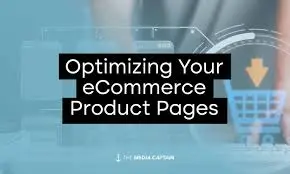SEO For E-commerce
How to Optimize an E-commerce Product Page for SEO?
In the highly competitive world of e-commerce, having a beautifully designed website with a wide range of products is only half the battle. To truly succeed, your product pages need to rank well in search engines. Optimizing your e-commerce product pages for SEO is crucial to driving organic traffic and converting visitors into customers.
Why SEO Matters for E-commerce Product Pages?
Search engine optimization (SEO) is the process of enhancing your website so that it ranks higher in search engine results pages (SERPs). For e-commerce, this is particularly important because:
Increased Visibility: Higher rankings mean more people can find your products when they search for relevant terms.
Better User Experience: SEO best practices often align with improving the user experience, which can lead to higher conversion rates.
Higher Conversion Rates: By targeting the right keywords and providing valuable content, you can attract more qualified traffic that is more likely to convert.
Key Steps to Optimize Your E-commerce Product Pages
1. Conduct Keyword Research
A successful SEO strategy begins with thorough keyword research. Identify the terms and phrases your potential customers are using to search for products like yours.
Use Tools: Utilize keyword research tools like Google Keyword Planner, Ahrefs, or SEMrush to discover relevant keywords.
Focus on Long-Tail Keywords: These are more specific and less competitive, making them easier to rank for and more likely to convert.
Consider Search Intent: Understand what the user is looking for when they search for a particular keyword. Are they looking for information, a comparison, or ready to buy?
2. Optimize Product Titles
Search engine optimization relies heavily on your product title. It should be clear, descriptive, and include the primary keyword.
Include Key Details: Mention the brand, product type, and any important features like size, color, or model.
Keep It Concise: Aim for around 50-60 characters, so the title doesn’t get cut off in search results.
Use Natural Language: Avoid keyword stuffing; your title should read naturally.
3. Write Compelling Meta Descriptions SEO For E-commerce
The meta description is the short paragraph that appears under your title in search results. While it doesn’t directly affect rankings, it influences click-through rates.
Include Your Main Keyword: This can help Google understand the relevance of your page.
Highlight Unique Selling Points (USPs): Mention what makes your product stand out, such as free shipping, discounts, or special features.
Create a Call to Action: Encourage users to click by using phrases like “Shop now” or “Discover more.”
4. Use Descriptive, Keyword-Rich URLs
Search engine optimization benefits from a clean and descriptive URL structure.
Include the Product Name: Your URL should clearly indicate what the page is about.
Avoid Stop Words: Remove unnecessary words like “and,” “or,” “the.”
Hyphens help improve readability by separating words.
5. Optimize Product Descriptions
Product descriptions are a critical aspect of on-page SEO. They should be detailed, informative, and optimized for your target keywords.
Use Natural Language: Write for humans first, search engines second. Avoid keyword stuffing.
Highlight Key Features and Benefits: Explain what makes the product unique and how it solves the customer’s problem.
Include Keywords Naturally: Incorporate your primary and secondary keywords in a way that feels natural.
Add Unique Content: Avoid using the manufacturer’s generic description. Unique content helps you stand out and rank better.
6. Optimize Product Images For SEO E-commerce
High-quality images are essential for e-commerce, but they also need to be optimized for SEO.
Use Descriptive File Names: Rename your images with descriptive, keyword-rich filenames before uploading them.
Add Alt Text: Search engines interpret alt text as a description of the image. It’s also crucial for accessibility.
Compress Images: Ensure your images are optimized for web use to avoid slowing down your site.
Use Multiple Images: Show different angles, zoom-ins, and lifestyle shots to give a comprehensive view of the product.
7. Implement Schema Markup
Schema markup is structured data that helps search engines understand the content of your page better. For e-commerce, product schema can provide rich snippets in search results, such as star ratings, price, and availability.
Use Product Schema: Implement schema markup that includes details like name, image, description, brand, SKU, price, and availability.
Test Your Markup: Utilize Google’s Rich Results Test tool to verify the proper implementation of your markup.
8. Optimize for Mobile For SEO E-commerce
With the majority of online shopping now happening on mobile devices, optimizing your product pages for mobile is crucial.
Responsive Design: Guarantee that your website is entirely responsive and delivers a smooth experience across all devices.
Mobile-Friendly Buttons: Use large, easily tappable buttons for adding products to the cart.
Fast Load Times: Compress images, minimize code, and use caching to speed up your site on mobile.
9. Encourage Customer Reviews
User-generated content like reviews not only builds trust but also adds fresh, relevant content to your product pages, which can boost SEO.
Make It Easy to Leave Reviews: Use a simple and intuitive review process.
Respond to Reviews: Interact with customers by addressing both favorable and unfavorable reviews.
Incorporate Keywords: Encourage customers to mention specific product features in their reviews.
10. Improve Page Load Speed
Page load speed is a critical ranking factor for both desktop and mobile searches.
Use a Content Delivery Network (CDN): CDNs distribute your content globally, reducing load times.
Enable Browser Caching: This contributes to reducing load times for users who return to the site.
Minimize HTTP Requests: Decrease the quantity of elements on your webpage to enhance loading speed.
Conclusion
Optimizing your e-commerce product pages for SEO is essential to driving organic traffic and increasing conversions. By focusing on keyword research, product titles, meta descriptions, URLs, product descriptions, and other elements, you can create product pages that not only rank well but also provide a great user experience. By applying these strategies, you will be on the path to achieving success in e-commerce.

Leave a Reply